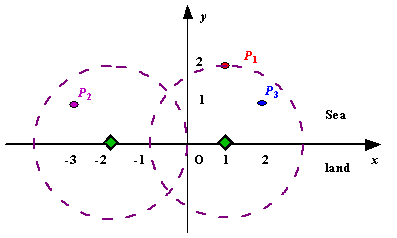1328:Radar Installation
-
总时间限制:
- 1000ms 内存限制:
- 65536kB
-
描述
-
Assume the coasting is an infinite straight line. Land is in one side of coasting, sea in the other. Each small island is a point locating in the sea side. And any radar installation, locating on the coasting, can only cover d distance, so an island in the sea can be covered by a radius installation, if the distance between them is at most d.
We use Cartesian coordinate system, defining the coasting is the x-axis. The sea side is above x-axis, and the land side below. Given the position of each island in the sea, and given the distance of the coverage of the radar installation, your task is to write a program to find the minimal number of radar installations to cover all the islands. Note that the position of an island is represented by its x-y coordinates.

Figure A Sample Input of Radar Installations
输入
-
The input consists of several test cases. The first line of each case contains two integers n (1<=n<=1000) and d, where n is the number of islands in the sea and d is the distance of coverage of the radar installation. This is followed by n lines each containing two integers representing the coordinate of the position of each island. Then a blank line follows to separate the cases.
The input is terminated by a line containing pair of zeros
输出
- For each test case output one line consisting of the test case number followed by the minimal number of radar installations needed. "-1" installation means no solution for that case. 样例输入
-
3 2 1 2 -3 1 2 1 1 2 0 2 0 0
样例输出
-
Case 1: 2 Case 2: 1
#include<iostream>
#include<algorithm>
#include<cstring>
#include<cstdio>
#include<cmath>
using namespace std;
struct pos
{
double x; //因为一开始思路出现了一点小小的问题,所以姑且认为这两个结构体等价就行了
double y;
}position[1005];//记录小岛的横纵坐标结构体,其实没必要这样,需要两个变量就够了
struct posi
{
double x;
double y;
}coor[1005];//记录小岛在x轴上投影的结构体 x为断点,y为右端点
int n,m;
bool cmp(struct posi r1, struct posi r2)
{
return r1.x<r2.x;
} //对投影区间进行排序
int greedyheart()//贪心算法关键部分
{
int x;
int num=0;
int len=0;
int count=1;
double temp = coor[0].y; //先给一组区间右端点最小值赋予初值
for(int j = 1; j < n; j++)
{
if(coor[j].y < temp) //不断更新区间右端点最小值
temp = coor[j].y;
else if(coor[j].x > temp)
{ //如果有左端点超过右端点,雷达数就加1
count++;
temp = coor[j].y;
}
}
return count;//返回雷达数
}
int main()
{
int flag=0;
int test=0;
int number;
while(scanf("%d%d",&n,&m))
{
flag=0;
number=0;
if(n==0&&m==0)
break;
for(int i=0;i<n;++i)
{
cin>>position[i].x>>position[i].y;
coor[i].x=position[i].x-sqrt(1.0*(m*m-position[i].y*position[i].y));
coor[i].y=position[i].x+sqrt(1.0*(m*m-position[i].y*position[i].y)); //将岛的横纵坐标反映到x轴上的区间
if(position[i].y>m)
{
flag=1; //此种情况必然无解,不解释
}
}
if(flag)
{
printf("Case %d: -1\n",++test); //无解就这样做
continue;
}
sort(coor,coor+n,cmp); //对投影区间按照左端点从小到大排序
printf("Case %d: %d\n",++test,greedyheart());
}
return 0;
}






















 718
718

 被折叠的 条评论
为什么被折叠?
被折叠的 条评论
为什么被折叠?








